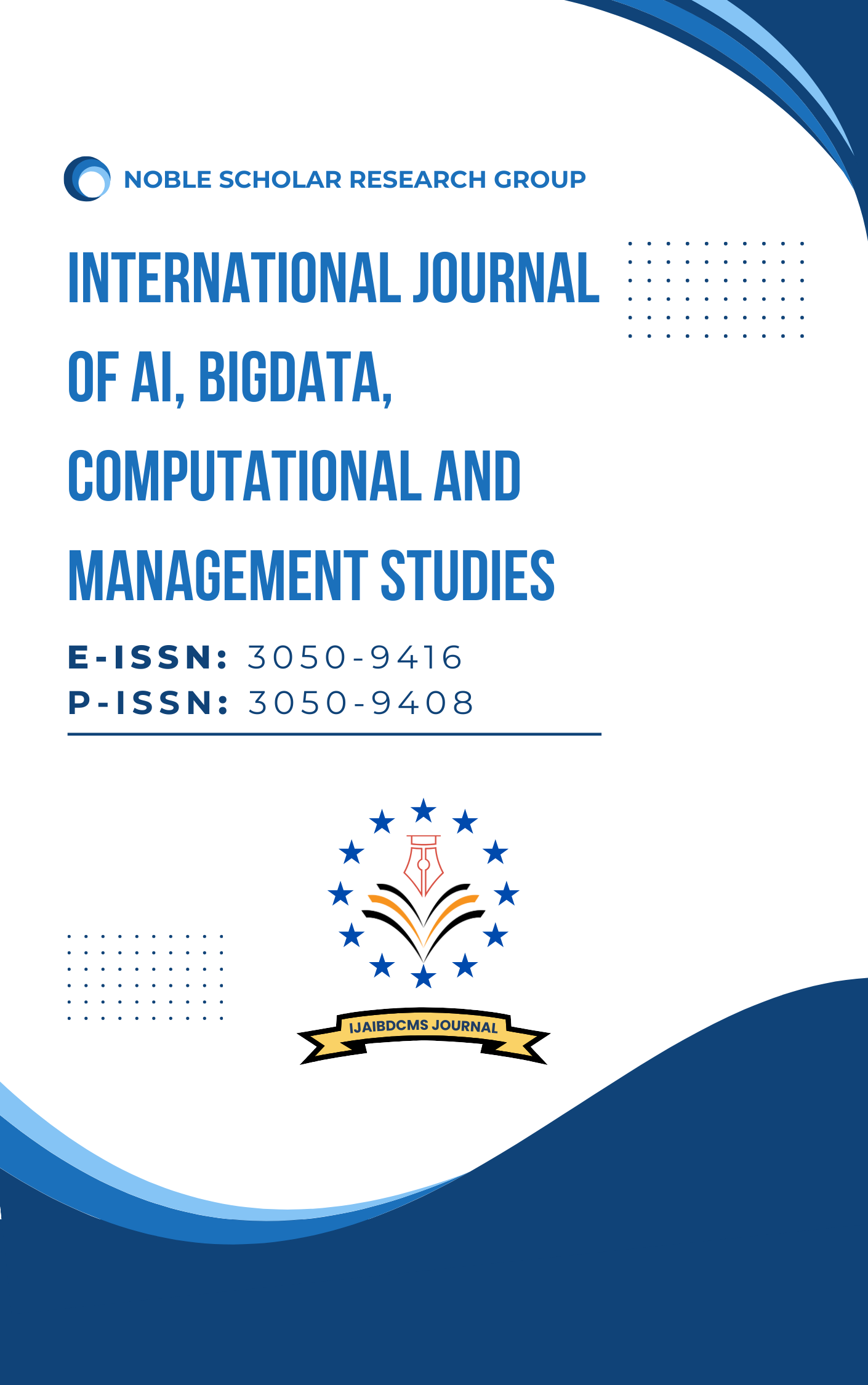Prescriptive AI in Procurement: Using Oracle AI to Recommend Optimal Supplier Decisions
DOI:
https://doi.org/10.63282/3050-9416.IJAIBDCMS-V2I1P108Keywords:
Prescriptive AI, Procurement Optimization, Oracle Adaptive Intelligent Apps, Supplier Recommendation, Dynamic DiscountingAbstract
The increased globalization of supply chains and procurement systems has contributed to the demand for more intelligent data-based decision-making by organizations. The paper presents the dynamics of the use of prescriptive Artificial Intelligence (AI) in purchasing and procurement using the Oracle Adaptive Intelligent Apps as the case study. In contrast to the traditional predictive systems that simply render predictions about the possible outcomes, prescriptive AI not only foresees the future but also advises what to do in order to receive the best results. Adaptive Intelligent Apps Oracle Fusion Cloud Procurement uses internal data to improve procurement performance and performance analytics in ERP and external market indicators to provide meaningful recommendations that guide actions like alternate supplier recommendation, real-time dynamic discount negotiation, and real-time compliance. The system architecture involves the combination of data intake, machine learning and a decision engine, which analyses supplier performance, risk profiles and procurement policies. With these capabilities, procurement teams are able to automate routine functions, shorten sourcing cycle times, and make situation-aware decisions. A case study which has been applied in the real-world arena of a global industrial enterprise reveals fundamental benefits that can be measured through positive changes in RFQ cycle times, as well as increased compliance rates and large amounts of cost reductions. Analysis indicates that a robust, technologically sound definition of prescriptive AI aligns with the future-proof demands of modern procurement, as well as Oracle's organisational strategy. This paper will contribute to the knowledge about how AI embedded in an ERP system promises to transform procurement, a predominantly reactive and transactional activity, into a proactive, strategic, value-driven, and resilient process
References
1. Chopra, A. (2019, February). AI in supply & procurement. In 2019, Amity International Conference on Artificial Intelligence (AICAI) (pp. 308-316). IEEE.
2. Richard, A. C. (2003). Overview of Budget Systems and Public Procurement in OECD Countries. The Environmental Performance of Public Procurement, 101.
3. Nissen, M. E. (2009). Procurement: process overview and emerging project management techniques. The Wiley Guide to Project Technology, Supply Chain & Procurement Management, 247.
4. Rahmani, F., Maqsood, T., & Khalfan, M. (2017). An overview of construction procurement methods in Australia. Engineering, construction and architectural management, 24(4), 593-609.
5. Kumaraswamy, M. M., & Dissanayaka, S. M. (1998). Linking procurement systems to project priorities. Building Research & Information, 26(4), 223-238.
6. Bulut, C., & Yen, B. P. (2013). E-procurement in the public sector: a global overview. Electronic Government, an International Journal, 10(2), 189-210.
7. Dash, R., McMurtrey, M., Rebman, C., & Kar, U. K. (2019). Application of artificial intelligence in the automation of supply chain management. Journal of Strategic Innovation and Sustainability, 14(3), 43-53.
8. Adra, H., Roeder, T. M. K., Frazier, P. I., Szechtman, R., Zhou, E., & Huschka, T. (2016). Real-time predictive and prescriptive analytics with real-time data and simulation. In Proceedings of the 2016 Winter Simulation Conference (pp. 3646-3651). Institute of Electrical and Electronics Engineers, Inc..
9. Krumeich, J., Werth, D., & Loos, P. (2016). Prescriptive control of business processes: new potentials through predictive analytics of big data in the process manufacturing industry. Business & Information Systems Engineering, 58, 261-280.
10. Soma, R., Bakshi, A., & Prasanna, V. K. (2007, July). An architecture of a workflow system for Integrated Asset Management in the smart oil field domain. In 2007 IEEE Congress on Services (Services 2007) (pp. 191-198). IEEE.
11. Lepenioti, K., Bousdekis, A., Apostolou, D., & Mentzas, G. (2019). Prescriptive analytics: Literature review and research challenges. International Journal of Information Management, 50, 57–70.
12. Behera, R. K., Bala, P. K., & Jain, R. (2020). A rule-based automated machine learning approach in the evaluation of a recommender engine. Benchmarking: An International Journal, 27(10), 2721-2757.
13. Chopra, A. (2018, October). Technology in procurement and supply is prevalent today and has a scope for the future. In 2018 International Conference on Automation and Computational Engineering (ICACE) (pp. 216-223). IEEE.
14. Schrage, M. (2020). Recommendation engines. MIT Press.
15. Biswas, A., Vineeth, K. S., & Jain, A. (2020, January). Development of a product recommendation engine by collaborative filtering and association rule mining using machine learning algorithms. In 2020 Fourth International Conference on Inventive Systems and Control (ICISC) (pp. 272-277). IEEE.
16. Zhou, Y., Cui, S., & Wang, Y. (2019, July). Development of a machine learning based recommendation engine for embedded programmers. In 2019 IEEE 9th International Conference on Electronics, Information and Emergency Communication (ICEIEC) (pp. 634-637). IEEE.
17. Sola, S. R. (2019). B2B and Cloud Integration with Oracle Integrated SOA Gateway and OIC. International Journal of Engineering Technology Research & Management (IJETRM).
18. Van Molken, R., & Wilkins, P. (2017). Implementing Oracle integration Cloud service. Packt Publishing Ltd.
19. Lindlbauer, D., Feit, A. M., & Hilliges, O. (2019, October). Context-aware online adaptation of mixed reality interfaces. In Proceedings of the 32nd annual ACM symposium on user interface software and technology (pp. 147-160).
20. Stackowiak, R., Rayman, J., & Greenwald, R. (2007). Oracle data warehousing & business intelligence Solutions. John Wiley & Sons.
21. Juric, K. (2019). Oracle CX Cloud Suite: Deliver a seamless and personalized customer experience with the Oracle CX Suite. Packt Publishing Ltd.
22. Pappula, K. K., & Anasuri, S. (2020). A Domain-Specific Language for Automating Feature-Based Part Creation in Parametric CAD. International Journal of Emerging Research in Engineering and Technology, 1(3), 35-44. https://doi.org/10.63282/3050-922X.IJERET-V1I3P105
23. Rahul, N. (2020). Optimizing Claims Reserves and Payments with AI: Predictive Models for Financial Accuracy. International Journal of Emerging Trends in Computer Science and Information Technology, 1(3), 46-55. https://doi.org/10.63282/3050-9246.IJETCSIT-V1I3P106
24. Enjam, G. R. (2020). Ransomware Resilience and Recovery Planning for Insurance Infrastructure. International Journal of AI, BigData, Computational and Management Studies, 1(4), 29-37. https://doi.org/10.63282/3050-9416.IJAIBDCMS-V1I4P104



